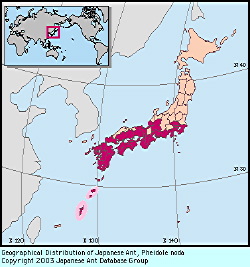
|
species
|
Pheidole noda
|
 |
Original Reference
|
|
Smith, F. (1874) Descriptions of new species of Tenthredinidae, Ichneumonidae, Chrysididae, Formicidae, &c. of Japan. Transactions of the Entomological Society of London (4) 7: 373-409.
|
Synonym
|
|
Pheidole nodus Fr. Smith (Fr. Smith, 1874) ,
Pheidole nodus var. praevexata Wheeler (Wheeler, 1929) ,
|
Description
|
|
Total length of body around 4.5 mm in soldiers, around 3 mm in workers. Head and gaster blackish brown, remainder reddish brown. In soldiers: gular dentition with paired lateral projections and obscure median projections; postpetiole larger than petiole. In workers: posterior portion of head rounded, with more or less distinct occipital carina.
|
Remarks
|
|
P. noda is easily distinguished from other Japanese Pheidole species by its large postpetiole. This is one of the most common ants in southwestern Japan. Found in open land and woodland or its margins. Colonies are large, comprising up to ca 3,000 individuals (Yano, pers. comm.). Soldiers dissect large food items and defend the nest and surrounds (Yano & Yamane, 1990). The presence of hostile ants does not influence soldier production (Nakao, 1973). Imai & Kubota (1972) reported chromosomal variation. This species has been previously called "Pheidole nodus", which is incorrect according to the International Code of Zoological Nomenclature, article 32d (Bolton, 1995).
|
|

Distribution
|
|
Honshu, Shikoku, Kyushu, Nansei Is; Mainland China, Korean Peninsula, Taiwan, India, Sri Lanka.
|
|
References
|
|
- Yano, M. & Sk. Yamane (1990). Division of larbour between the worker subcastes in Pheidole. . Insectarium, 27, 402-410. .
- Nakao, S. (1973). Colony development of Pheidole nodus Smith in artificial nest (Hymenoptera, Formicidae). Mushi, 47, 19-29.
- Imai, H. T. & M. Kubota (1972). Karyological studies of Japanese ants (Hymenoptera, Formicidae). III. Karyotype of nine species in Ponerinae, Formicinae, and Myrmicinae. Chromosoma, 37, 193-200.
- Bolton , 1995
|
Editor
|
|
Original text by Kazuo Ogata and Seiki Yamane. English translation by Kazuo Ogata, edited by Robert W. Taylor.
|
|